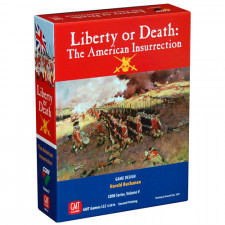Liberty or Death: The American Insurrection Review
on May 6, 2016
George Washington: Hero. Leader. Traitor.
Wait...what? It’s not often that the first president of the United States is referred to as a traitor. In a way though, the patriots were traitors. At the very least they were an insurgent force and it’s through that lens that Liberty or Death approaches the Revolutionary War. Liberty or Death is the fifth game in the COIN series. This system zooms out on conflicts and presents the political battlefield as much as the bloodied ground.
Liberty or Death expands the scope past the typical British vs Patriots mentality. Native American tribes mass on the edges and raid the colonies on behalf of the Redcoats. French regulars drag Patriot forces into open conflict with the Royalist forces. Tied together more than previous COIN titles, allies now directly share their primary victory conditions. The Royalists want popular support of the crown, the Rebel forces want...rebellion. In many ways this forces greater cooperation. In others, it puts a sharp edge to that teamwork; players must pay very close attention to their partner’s secondary condition if they want that victory for themselves. If your “ally†has completed their secondary victory condition it might be time to work tacitly with an opponent or sandbag the primary goal. The French were known to work with the Indians after all.
This thread of tense cooperation is woven throughout the starkly asymmetrical factions. The Indians can do little to directly raise support or remove Patriot forts. They depend on the British to do the bulk of the fighting. In exchange they can soften up the Rebellion and weaken them economically through raids and plundering. Like the Indians, the French will spend part of the game trying to win in more subtle ways. The French don’t even begin the game on the board, forced to build up and use events to influence the game until they enter via treaty. It’s an interesting perspective and follows the history, but it can be mildly unfun for that player. It feels like you’re a slave to the history without the room to stretch out and breathe.
No doubt the grognards out there are sharpening their corner clippers at me, but the stronger historical focus in Liberty or Death is my least favorite part. There is no doubt that all the COIN games are rooted in history and reality, but this one pushes just a little further towards “wargame†than I prefer. The map is gorgeous but Massachusetts may as well be renamed The Commonwealth of Overflow A. On the other hand, Quebec is so long and narrow it’s difficult to appreciate how many spaces are adjacent. In one game a player completely forgot he had pieces there because he’d offhandedly put them on one end of the space. Player error for sure, but the more geographically accurate map isn’t necessarily doing you any playability favors.
That attention to historical detail can also be constraining. The mechanics drive the British to control the cities in such a strong and direct way that there seems to be no room to develop an alternate strategy. I once found all of my British forces outside Rebellion occupied cities and it took over a campaign and a half to feel competent again. British commands and resource allocation place a strong emphasis on controlling cities. The ability to pivot to a colony-focused strategy could have been an interesting romp through an alt-history, but alas this isn’t the game for that
Some may consider simulation a strength they will be happy to know that the COIN system holds up. The dice based combat meant to simulate the uncertainty of musket-era combat works well. I always enjoy the thrill that comes with desperate combat relying on chance, though the loss-tables ensure that a strong tactician will usually come out on top. Long term strategy stacks on campaign-length goals achieved through colony level tactics. And while the French player may balk at her initial role, it does allow for a dramatically different gaming experience than the other COINs.
This is undeniably a good thing. The key mechanics of COIN are all here. The excellent card-driven system marches the game forward with the steady beat of the fife-and-drum. One event card is in play each turn which determines the round’s turn order. Only two factions can play however, and if you play this turn you are ineligible in the next. Any system that can make you think hard about deliberately skipping your own turn is a good one. The pseudo-alliance provides a fantastic framework for a game that blends area control and dudes on a map.
As the cards flip forward through actual historical events they present two interpretations of a single event. An event’s effect depends on which side of the conflict executes it. This contributes to the unique perspective in which we explore the Revolutionary War. The Burning of Falmouth executed by the British frightens the patriots and results in removing resources and militia; executed by the Patriots it galvanizes the population resulting in new forces for the Continental Army. Apart from the educational perspective this provides, it keeps each game feeling fresh and new. Hate the Declaration of Independence? Play cleverly and take it for yourself or prevent the Patriots from playing it all together.
Liberty or Death is deep and complex. It’s actually fairly easy to play mechanically, but the strategy is not clear until you’ve worked your way through a number of times. Immensely rewarding, it’s a top notch game that exceeded my expectations of a historical COIN. While the simulation aspects are not to my taste, anyone who enjoys them or enjoys the time period could easily add half a star or more to my score.

 Customer Support
Customer Support  Subscribe
Subscribe 




 Account
Account  Wishlist
Wishlist 

